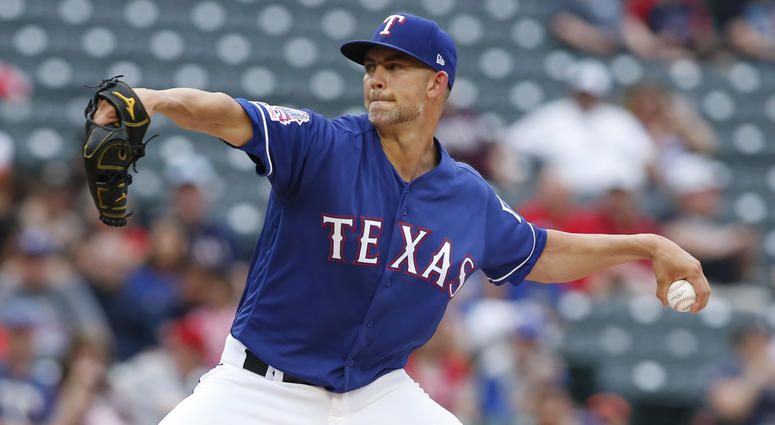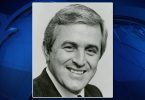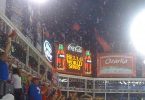Because a major league ballplayer’s season seems unending – 162 games in length and consequence – submission fails to rank high on the list of accepted fates.
To the player, there is always another game, another opposing pitcher to face, another day to cling to the fading math of the wild card standings – until suddenly there isn’t.
It wasn’t surprising, therefore, to hear that general manager Jon Daniels’ frank assessment of the Texas Rangers’ trade deadline options served to divert the club into its recent week-long tailspin.
The players wanted Daniels to send in the cavalry. Instead he sent them a cloud.
They wanted help. Daniels tempered his response with a patient scan of the franchise blueprints.
The Rangers don’t necessarily need new players. They need the ones they already have to start hitting and pitching better.
As the calendar prepares to turn to August, nonetheless, the Rangers are a .500 baseball team. Say that back in spring training, and nearly every Rangers fan would have been staggered and delighted. So there’s that.
The eight-game freefall took the bloom off the rose. After shutting out Tampa Bay to go 10 games over .500 on June 28, the Rangers have won only seven of 24.
Hold on to those Billy Joel concert tickets, in other words. An October scheduling dilemma is not going to be a problem.
On the TV postgame show after a recent ugly loss in Seattle, the suggestion was made that it was about time for the team’s clubhouse leaders to “get mad.”
A noble idea, but who exactly is going to be overturning the postgame buffet? Who, if anyone, has the clubhouse’s most audible bark? And what’s he going to say, anyway . . . play better?
Or else . . . what?
The spunky, no-quit gang we saw in April, May and June has reached its ceiling. The lineup finally has paid the price for stacking three sub-.200 hitters at its lower flanks. The pitching staff no longer is overachieving, and the Shawn Kelley-less bullpen has been rendered wafer thin.
Disappointed? Don’t be.
This season was never supposed to be about wild cards and how many Rangers made the All-Star team. The joint task for Daniels and manager Chris Woodward in this final year at The Ballpark in Arlington was instead designed to determine the best 25 going forward, for when the new park flips on the AC.
Which is why some of us were disarmed by the pre-All-Star chatter about whether the Rangers should be buyers or sellers. The franchise had an entire offseason to answer that question, and general manager Daniels’ reserved response clearly answered it.
Buyers? What would have been the point? At best, the club would have been trading possible future assets for an inevitable divisional round defeat at the hands of the Yankees or Astros. The franchise – and its fans — need to be thinking bigger than that.
With the trade deadline coming Wednesday at 3 p.m., the Rangers don’t find themselves with contenders banging on their door.
Teams have been proceeding cautiously, unless you’re the Mets or Rays.
Daniels justifiably appears to have placed a high price tag on starting pitcher Mike Minor. The All-Star left-hander is signed through 2020 at a modest and affordable $9.833 million.
More importantly, the Rangers don’t need to trade Minor, leaving them owning the leverage in any potential deal.
When Toronto traded Marcus Stroman to Tampa Bay on Sunday, it left Minor as the consensus best starting pitcher available.
On the one hand, it had to disappoint Rangers management that Stroman was only able to reap in return the New York Mets’ Nos. 4 and 6 prospects. But who’s to say what the Mets are thinking?
New York began Monday with a 50-55 record, fourth in the National League East, 11 ½ games behind Atlanta and six games out in the wild card race.
They can’t be that delusional. A more plausible scenario would be the Mets holding on to Stroman and next trading either Noah Syndergaard or Zack Wheeler, both starting pitchers.
I’m not sure what it says when the contenders in both leagues were unwilling to offer more for Stroman than prospects Simeon Woods-Richardson and Anthony Kay.
If they aren’t more willing than that, Minor likely will remain with the Rangers. Woods-Richardson is 18 years old and pitching at the Low-A level. Kay is 24 and has a 6.61 earned run average in Triple A.
On this, I bow to my colleagues who trawl the minor league box scores and spin rates and who compile dossiers on baseball’s young prospects.
Myself, frankly, I’m tired of seeing the Rangers trade for low-level prospects. Some of us may not be around in 2025, when maybe those prospects might actually appear in a major league game.
Baseball America wrote about what’s happened to the prospects who were traded at the deadline. Of the 428 young players who were swapped between 2003 and 2014, only 86 of them – 20.1% — rose to play at least two seasons in the big leagues and compile a positive WAR. Of the 43 who were traded at the deadline in 2009, only five have made it – 11.6%.
Exceptions exist. Corey Kluber, Josh Donaldson, Nelson Cruz, David Murphy, Elvis Andrus and Shin-Soo Choo were all deadline-traded as young prospects.
But most Rangers fans don’t care to share in the joy if the Down East Wood Ducks happen to win another pennant.
Granted, a robust farm system enhances a franchise’s portfolio. It’s a long wait, though, between the rookie leagues, the slow climb through the Carolinas, the inevitable Tommy John rehabilitation and maybe, if all goes well, a promising spring training with the big club.
Case in point: pitcher Cole Ragans, the Florida high schooler who was the Rangers’ No. 1 pick in 2016. He had Tommy John surgery and missed all of 2018, and then had to have a second Tommy John procedure and is missing 2019.
If Daniels trades for prospects below the Double-A Texas League level, therefore, he should expect a tepid response from the ticket buying public, especially if the deal includes Minor or Lance Lynn.
The Rangers should be hoarding major league quality starting pitchers, not swapping them for bags of beans. If Minor and/or Lynn is traded, they will have to be replaced and the franchise will continue to chase its own tail.
In its current ranking of major league farm systems, Baseball America has the Texas Rangers as No. 28 of 30. How could they possibly hope to dip into their own organization and replace their two most solid starters?
The bullpen is a different matter. Daniels should be eager to listen if a contending GM calls to ask about relievers Chris Martin, Jesse Chavez or Jose Leclerc. In particular, Leclerc owns a contract that ensures club control through 2022.
Fantasy league players – you know who you are – seem to think it’s as easy as texting the other general manager. Just trade Choo or Nomar Mazara or Hunter Pence, they say.
Stop it, though. Where’s the fit in a contender’s lineup for any of those three?
If the club has gone this far with Rougned Odor – 90 games played and 359 plate appearances with a .200 batting average and a .681 OPS – it owes itself to be at least as patient with Nomar Mazara, still only 24 years old.
Therein lies the dark cloud of this 2019 season – not that the team faded after the All-Star break and couldn’t sustain a wild-card chase, but rather that Odor, Mazara and Ronald Guzman have all failed to take a solid step forward and prove they can be fixtures in a major league lineup for 2020 and beyond.
If nothing else, it would have made Wednesday’s trade watch a lot more interesting.







